Introduction
Dynamic pricing enables retailers to formulate optimal prices based on information such as consumer behavior, seasonality and competitors’ activity. Advancements in digital technology are enabling retailers’ dynamic pricing strategies to become increasingly accurate and effective.
In this report, we give an overview of the application of dynamic pricing in retail. We will show why retailers adopt the strategy, what factors algorithms consider in formulating prices and how consumers perceive the practice. We will also show how dynamic pricing is used by Amazon to help the company retain its competitive pricing advantage, and how artificial intelligence (AI) virtual assistant devices could strengthen retailers’ dynamic pricing strategies.
Dynamic Pricing: Algorithms Set the Price
Dynamic pricing is a retail strategy that consists of the application of variable prices—rather than fixed prices—to the sales of products and services.
Digitalization has made it easier for retailers to achieve price optimization through dynamic pricing strategies. Technology such as AI and machine learning can be used to gather and analyze data that influence prices and to formulate optimal pricing according to the circumstances. Optimal prices are periodically calculated by dynamic pricing algorithms and updated to reflect changing conditions.
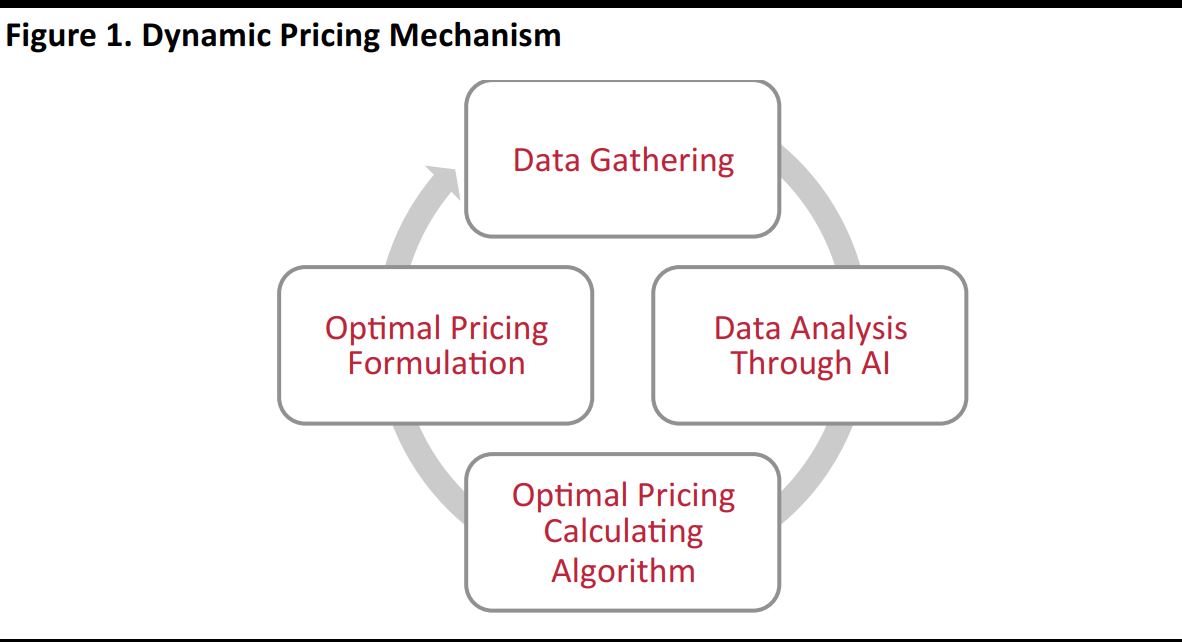 Source: CoreSight Research
Source: CoreSight Research
The main advantage of adopting dynamic pricing for retailers is the ability to offer the optimal price at the right time to the right customer, with the objective of maximizing sales conversion and margins.
This approach is not without its drawbacks, one of which is that it can frustrate consumers and discourage purchases. Consumers seeing continual changes in pricing could postpone their purchase, believing that prices will decrease in the future.
Optimal pricing is calculated taking into account several variables, including:
- Competitors’ prices: Competitors’ pricing is a key variable to consider in order to strengthen a retailer’s competitive edge. In this report, we show how Amazon constantly monitors the prices of online competitors to ensure it can offer cheaper pricing.
- Consumer behavior: Tracking the online behavior of consumers reveals information about their intention to buy. If a customer keeps returning to a product page, it is more than likely they are interested in buying. This could trigger the retailer to raise the price of the item, knowing that the prospective customer has already made their decision to purchase. Furthermore, raising the price could create a sense of urgency that would encourage immediate purchase prompted by the fear of a further price increase.
- Shopping periods: Prices can be adjusted according to the time period when demand for a certain item usually surges, such as before and during a holiday season such as Christmas.
Figure 2 shows how during Black Friday 2016, large retailers, including Amazon, Walmart and Target, changed prices on a significant share of their stock keeping units (SKU) at least once a day, according to software company 360pi.
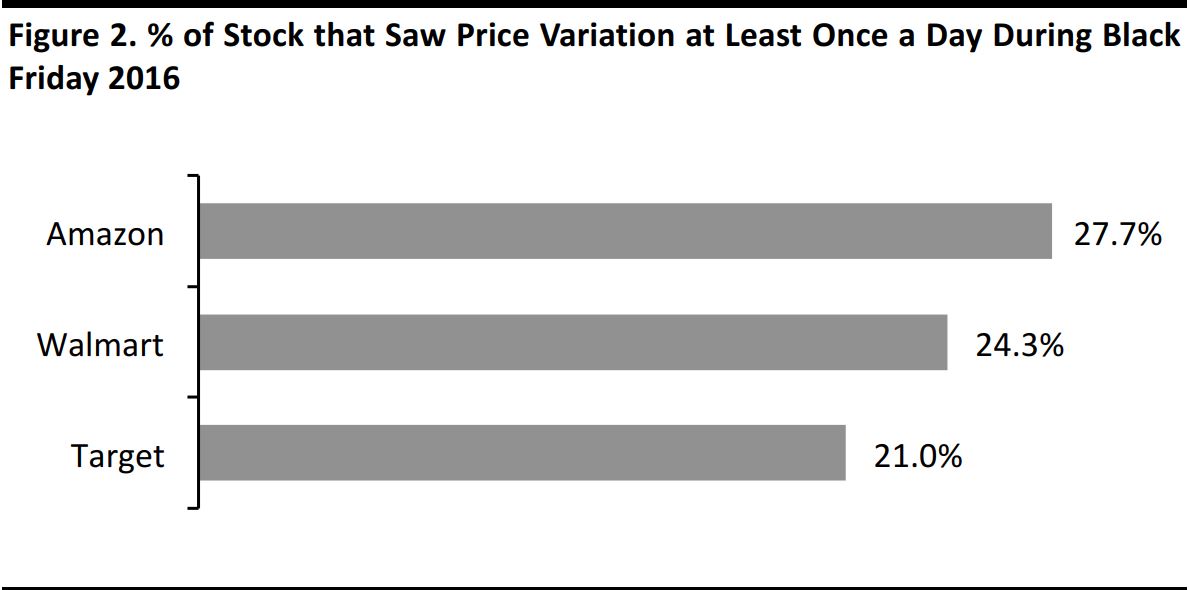 The percentage of the sampled assortment at each retailer that changed price at least once a day during Black Friday. Based on a sample of over 23,000 SKUs in Amazon’s assortment of electronics and matched to the other retailers. This includes products available online and in-stock for purchase. It does not include marketplace seller prices, additional discounting or coupon codes, loyalty programs, cardholder discounts, shipping or taxes.
Source: 360pi
The percentage of the sampled assortment at each retailer that changed price at least once a day during Black Friday. Based on a sample of over 23,000 SKUs in Amazon’s assortment of electronics and matched to the other retailers. This includes products available online and in-stock for purchase. It does not include marketplace seller prices, additional discounting or coupon codes, loyalty programs, cardholder discounts, shipping or taxes.
Source: 360pi
Other factors that influence pricing can be more specific to the category that the items to be priced belong to, for example weather conditions could affect the pricing of outdoor apparel.
How Amazon Implements Dynamic Pricing
Amazon’s use of dynamic pricing is one of the main examples of its application in retail and how a retailer benefits. One of the reasons behind Amazon’s commercial success is partially due to its reputation for competitive pricing.
Amazon constantly scans competitors’ prices and uses dynamic pricing algorithms to make pricing decisions based on the competitions’ pricing dynamics.
Third-party retailers selling on Amazon Marketplace compete in order to appear on the “buy box” for a product. While a vendors’ position on this buy box is determined by factors such as sales volume and reviews, price is also a key determinant, and the most sophisticated vendors use their own dynamic pricing algorithms in order to make sure they always stand out from their rivals.
Amazon uses this price battle that takes place among third-party retailers on Amazon Marketplace to price similar products, ensuring that Amazon.com always offers the best price.
Figure 3 provides an example of how dynamic pricing works on Amazon Marketplace.
- The price of the consumer electronic item sold directly by Amazon changed significantly during the period June 11, 2017 to February 3, 2018—peaking at $1,799 on November 7, 2017 and then declining to $1,599 on February 3, 2018.
- During the period examined, the price of the item sold through third-party retailers on Amazon Marketplace was, for the most part, higher than the price of the same item sold directly by Amazon.
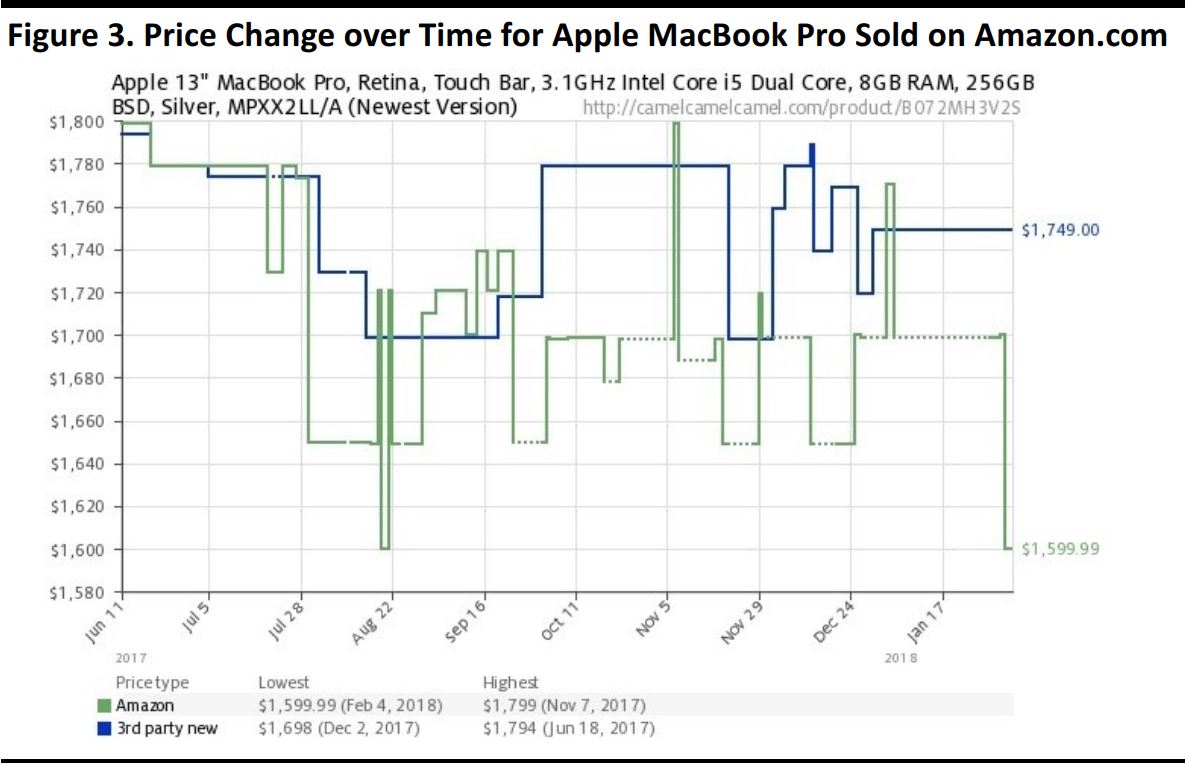 The green line tracks price changes of the item sold by Amazon; the blue line tracks price changes of the item sold by third-party sellers on Amazon Marketplace.
Source: Camelcamelcamel/Amazon
The green line tracks price changes of the item sold by Amazon; the blue line tracks price changes of the item sold by third-party sellers on Amazon Marketplace.
Source: Camelcamelcamel/Amazon
How Dynamic Pricing Is Perceived by Retailers and Consumers
One drawback of dynamic pricing is that it may frustrate shoppers, and their expectations for lower prices in the future could encourage them to postpone their purchase.
As shown in figure 4, the majority of consumers have a negative perception of the use of dynamic pricing by retailers, according to a survey undertaken by research firm RSR Research.
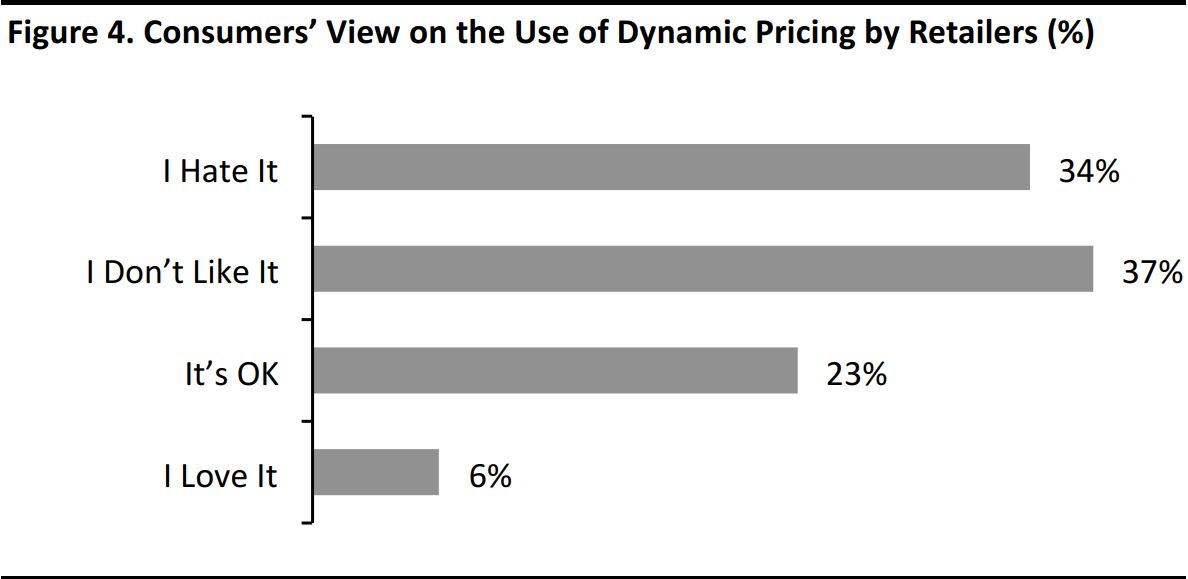 Survey undertaken in 1H17 in the US using a sample of 1,250 respondents.
Source: RSR Research
Survey undertaken in 1H17 in the US using a sample of 1,250 respondents.
Source: RSR Research
However, there are significant differences in the way consumers of different age groups perceive dynamic pricing. Younger demographics showed an appreciation for this pricing strategy. For instance, in the same survey undertaken by RSR Research, 14% of respondents aged 18–29 answered that they love the fact that retailers use dynamic pricing—compared to just 2% of respondents aged 60 and over—while 25% said that it is OK. These responses suggest that a large segment of younger consumers tend to see dynamic pricing as an opportunity to scout for better prices and not just a strategy for retailers to generate more revenue.
Unsurprisingly, retailers have a better perception of dynamic pricing. A survey of employees in the e-commerce sector undertaken by data publisher Statista in Germany in 2017 (figure 5), showed that 35% of respondents view dynamic pricing as an interesting trend and 16% see it as a game changer in the industry. However, a sizeable share of respondents perceives dynamic pricing as overhyped.
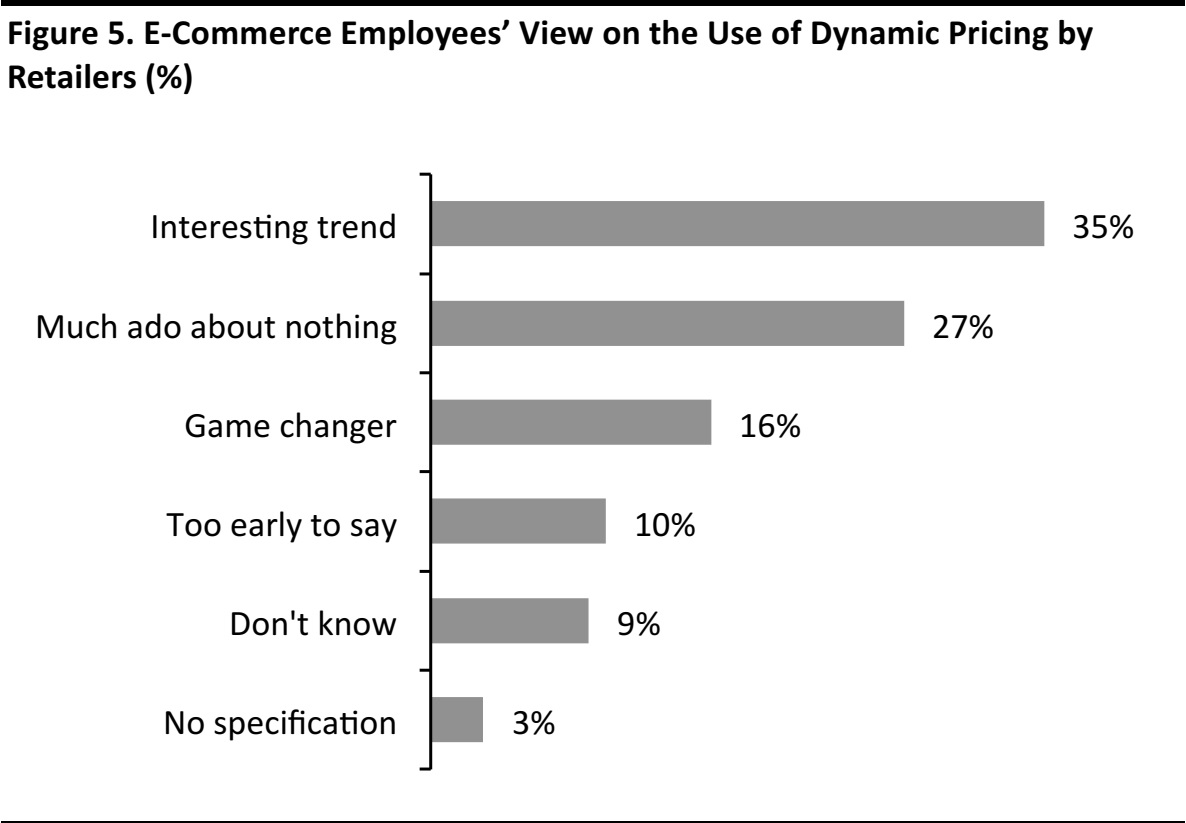 Survey undertaken in Germany during February 23 to May 30, 2017. Sample of 100 respondents among employees in the e-commerce sector that had been employed for at least two years.
Source: Statista-Expertenbefragung E-Commerce 2017
Survey undertaken in Germany during February 23 to May 30, 2017. Sample of 100 respondents among employees in the e-commerce sector that had been employed for at least two years.
Source: Statista-Expertenbefragung E-Commerce 2017
Home AI Virtual Assistant Devices Could Help Formulate Optimal Pricing
AI could further help retailers formulate bespoke price tags for each customer. AI-powered virtual assistant devices that customers have at home—such as Amazon Echo or Google Home—are an additional and significant source of information on users’ behaviors and preferences, conveyed in the way users interact with their virtual assistants, the kind of questions they ask and so on.
Dynamic pricing algorithms could use the information from the interaction between consumers and their virtual assistants to formulate optimal prices for items users order online through their virtual assistant.
A user ordering online through their virtual assistant would, in practice, delegate the negotiation of the price to the device. For instance, for repeat or impulse purchases, a shopper may order the item without considering the price, and the virtual assistant would process the order at the price formulated by the dynamic pricing algorithm. This removes the risk for the retailer that the shopper might be deterred from purchasing, knowing that the price has changed.
Key Takeaways
Dynamic pricing enables retailers to formulate optimal prices for each shopper according to the circumstances. Digital technology such as AI is used to gather shoppers’ information and data to inform dynamic pricing algorithms.
Dynamic pricing allows retailers to formulate the optimal price that is most likely to maximize sales conversion and margins. However, this strategy can also frustrate shoppers and encourage the postponement of the purchase decision, motivated by the belief that the price will decrease in the future.
Competitors’ pricing, consumer behavior and seasonality are the main factors taken into account by dynamic pricing algorithms.
Amazon’s use of dynamic pricing is one of the main examples of its application in retail. In order to offer competitive prices at all times, Amazon constantly scans competitors’ pricing and price levels set by third-party retailers on Amazon Marketplace to inform its own pricing.
The majority of consumers perceive dynamic pricing negatively, according to a survey undertaken by RSR Research, but there are significant differences between age groups, with younger demographics liking dynamic pricing and seeing it as an opportunity to scout for competitive prices.
AI virtual assistants are able to supply additional shopper data that can be used to formulate optimal pricing and could reduce users’ awareness of price changes, providing retailers with an additional tool to strengthen their dynamic pricing strategy.

 Source: CoreSight Research
Source: CoreSight Research The percentage of the sampled assortment at each retailer that changed price at least once a day during Black Friday. Based on a sample of over 23,000 SKUs in Amazon’s assortment of electronics and matched to the other retailers. This includes products available online and in-stock for purchase. It does not include marketplace seller prices, additional discounting or coupon codes, loyalty programs, cardholder discounts, shipping or taxes.
Source: 360pi
The percentage of the sampled assortment at each retailer that changed price at least once a day during Black Friday. Based on a sample of over 23,000 SKUs in Amazon’s assortment of electronics and matched to the other retailers. This includes products available online and in-stock for purchase. It does not include marketplace seller prices, additional discounting or coupon codes, loyalty programs, cardholder discounts, shipping or taxes.
Source: 360pi The green line tracks price changes of the item sold by Amazon; the blue line tracks price changes of the item sold by third-party sellers on Amazon Marketplace.
Source: Camelcamelcamel/Amazon
The green line tracks price changes of the item sold by Amazon; the blue line tracks price changes of the item sold by third-party sellers on Amazon Marketplace.
Source: Camelcamelcamel/Amazon Survey undertaken in 1H17 in the US using a sample of 1,250 respondents.
Source: RSR Research
Survey undertaken in 1H17 in the US using a sample of 1,250 respondents.
Source: RSR Research Survey undertaken in Germany during February 23 to May 30, 2017. Sample of 100 respondents among employees in the e-commerce sector that had been employed for at least two years.
Source: Statista-Expertenbefragung E-Commerce 2017
Survey undertaken in Germany during February 23 to May 30, 2017. Sample of 100 respondents among employees in the e-commerce sector that had been employed for at least two years.
Source: Statista-Expertenbefragung E-Commerce 2017